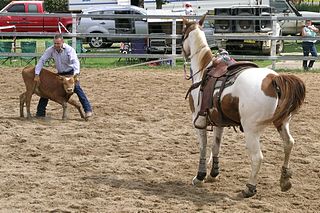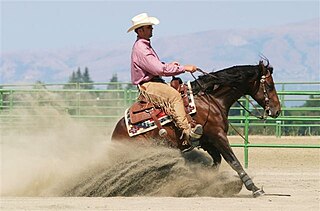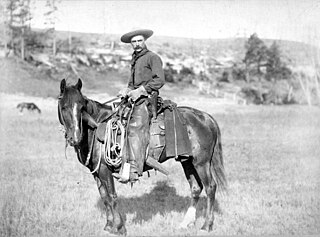
Equestrianism, commonly known as horse riding or horseback riding, includes the disciplines of riding, driving, and vaulting. This broad description includes the use of horses for practical working purposes, transportation, recreational activities, artistic or cultural exercises, and competitive sport.

Rodeo is a competitive equestrian sport which arose out of the working practices of cattle herding in Spain and Mexico, expanding throughout the Americas and to other nations. It was originally based on the skills required of the working vaqueros and later, cowboys, in what today is the western United States, western Canada, and northern Mexico. Today, it is a sporting event that involves horses and other livestock, designed to test the skill and speed of the cowboys and cowgirls. Professional rodeos generally comprise the following events: tie-down roping, team roping, steer wrestling, saddle bronc riding, bareback bronc riding, bull riding, breakaway roping, and barrel racing. The events are divided into two basic categories: the timed events and rough stock events. Depending on sanctioning organization and region, other events such as goat tying and pole bending may also be a part of some rodeos. The "world's first public cowboy contest" was held on July 4, 1883, in Pecos, Texas, between cattle driver Trav Windham and roper Morg Livingston.

A cowboy is an animal herder who tends cattle on ranches in North America, traditionally on horseback, and often performs a multitude of other ranch-related tasks. The historic American cowboy of the late 19th century arose from the vaquero traditions of northern Mexico and became a figure of special significance and legend. A subtype, called a wrangler, specifically tends the horses used to work cattle. In addition to ranch work, some cowboys work for or participate in rodeos. Cowgirls, first defined as such in the late 19th century, had a less-well documented historical role, but in the modern world work at identical tasks and have obtained considerable respect for their achievements. Cattle handlers in many other parts of the world, particularly South America and Australia, perform work similar to the cowboy.

Calf roping, also known as tie-down roping in the United States and Canada and rope and tie in Australia and New Zealand, is a rodeo event that features a calf and a rider mounted on a horse. The goal of this timed event is for the rider to catch the calf by throwing a loop of rope from a lariat around its neck, dismount from the horse, run to the calf, and restrain it by tying three legs together, in as short a time as possible. A variant on the sport, with fewer animal welfare controversies, is breakaway roping, where the calf is roped, but not tied.

Reining is a western riding competition for horses where the riders guide the horses through a precise pattern of circles, spins, and stops. All work is done at the lope, or the gallop. Originating from working cattle, reining requires the horse to be responsive and in tune with its rider, whose aids should not be easily seen, and judges the horse on its ability to perform a set pattern of movements. The horse should be willingly guided or controlled with little or no apparent resistance and dictated to completely. A horse that pins his ears, conveys a threat to his rider, refuses to go forward, runs sideways, bounces his rear, wrings his tail in irritation, or displays an overall poor attitude is not being guided willingly, and is judged accordingly. If a horse jogs or breaks gait it is a 0.

Charrería, is the national sport of Mexico and a discipline arising from equestrian activities and livestock traditions used in the haciendas of the Viceroyalty of New Spain.

Campdrafting is a unique Australian sport involving a horse and rider working cattle. The riding style is Australian stock, somewhat akin to American Western riding and the event is similar to the American stock horse events such as cutting, working cow horse, team penning, and ranch sorting.

Cutting is a western-style equestrian competition in which a horse and rider work together before a judge or panel of judges to demonstrate the horse's athleticism and ability to handle cattle. Modern competition utilizes a 2+1⁄2 minute performance, called a "run." Each contestant is assisted by four helpers: two are designated as turnback riders, who help to keep cattle from running off to the back of the arena, the other two are designated as herd holders to keep the cattle bunched together and prevent potential strays from escaping into the work area. Cutting cattle are typically young steers and heifers that customarily range in size from 400 to 650 lb. They usually are of Angus or Hereford lineage though may be a mix of crossbred beef cattle, including Charolais Braford or Brahman lineage.

Team penning is a western equestrian sport that evolved from the common ranch work of separating cattle into pens for branding, doctoring, or transport.

Western riding is considered a style of horse riding which has evolved from the ranching and welfare traditions which were brought to the Americas by the Spanish Conquistadors, as well as both equipment and riding style which evolved to meet the working needs of the cowboy in the American West. At the time, American cowboys had to work long hours in the saddle and often over rough terrain, sometimes having to rope a cattle using a lariat, also known as a lasso. Because of the necessity to control the horse with one hand and use a lariat with the other, western horses were trained to neck rein, that is, to change direction with light pressure of a rein against the horse's neck. Horses were also trained to exercise a certain degree of independence in using their natural instincts to follow the movements of a cow, thus a riding style developed that emphasized a deep, secure seat, and training methods encouraged a horse to be responsive on very light rein contact.

A cutting horse is a stock horse, typically an American Quarter Horse, bred and trained for cutting, a modern equestrian competition requiring a horse and rider to separate a single cow from a herd of cattle and prevent it from getting back to the herd. One of the desired qualities in a cutting horse is "cow sense," described as an innate ability to read a cow, eye to eye, in anticipation of each move. The cutting horse has its roots in the historic cattle ranching industry, where horses with specialized cattle-handling skills were crucial for the work of the cowboy.
History of rodeo tracks the lineage of modern Western rodeo.
The Canadian Cutting Horse Association is a non-profit organization dedicated to promoting the equestrian sport of cutting in Canada. Founded in 1954, it regulates a sport that began in the mid-1880s and became popular in Canada in the 1940s and 1950s. The CCHA maintains a Hall of Fame to honour members who have made outstanding contributions to the sport. The CCHA's patron is Prince Philip, Duke of Edinburgh. Cutting is a sport based on ranchwork that began in the early 19th century, cutting cattle out of herds. Horses and riders are judged on how well they work to remove a single steer from a herd and keep it from returning. The CCHA promotes a type of horse called the Canadian cutting horse; this type is made up of many breeds with a common stock horse background.

Working cow horse or reined cow horse is a type of Western riding competition in which horse and rider are tested for ability to work cattle. It is organised by the National Reined Cow Horse Association in North America, and by the European Reined Cow Horse Association in Europe. Horses are judged on accuracy, timing, and responsiveness.

A stock horse is a horse of a type that is well suited for working with livestock, particularly cattle. The related cow pony or cow horse is a historic phrase, still used colloquially today, referring to a particularly small agile cattle-herding horse; the term dates to 1874. The word "pony" in this context has little to do with the animal's size, though the traditional cow pony could be as small as 700 to 900 pounds and less than 14 hands high.

Bovine sports are sports that involve cattle, commonly a bull, ox, steer, cow or calf.

Para-equestrian is an equestrian sport governed by the International Federation for Equestrian Sports (FEI), and includes two competitive events. One is para-equestrian dressage, which is conducted under the same basic rules as conventional dressage, but with riders divided into different competition grades based on their functional abilities. The other is para-equestrian driving, which operates under the same basic rules as combined driving but places competitors in various grades based on their functional abilities.
A ranch rodeo is a traditional type of rodeo in which teams of cowboys or cowgirls from different ranches compete against each other in events based on the type of work they do every day.

Wild cow milking is a rodeo event seen at mainstream and ranch rodeos. A team-based competition, the goal is to catch and milk a "wild" cow in as short a time as possible. The competition dates back at least to the early 20th century, with competitions at the Cheyenne Frontier Days rodeo photographed as far back as 1924.


















